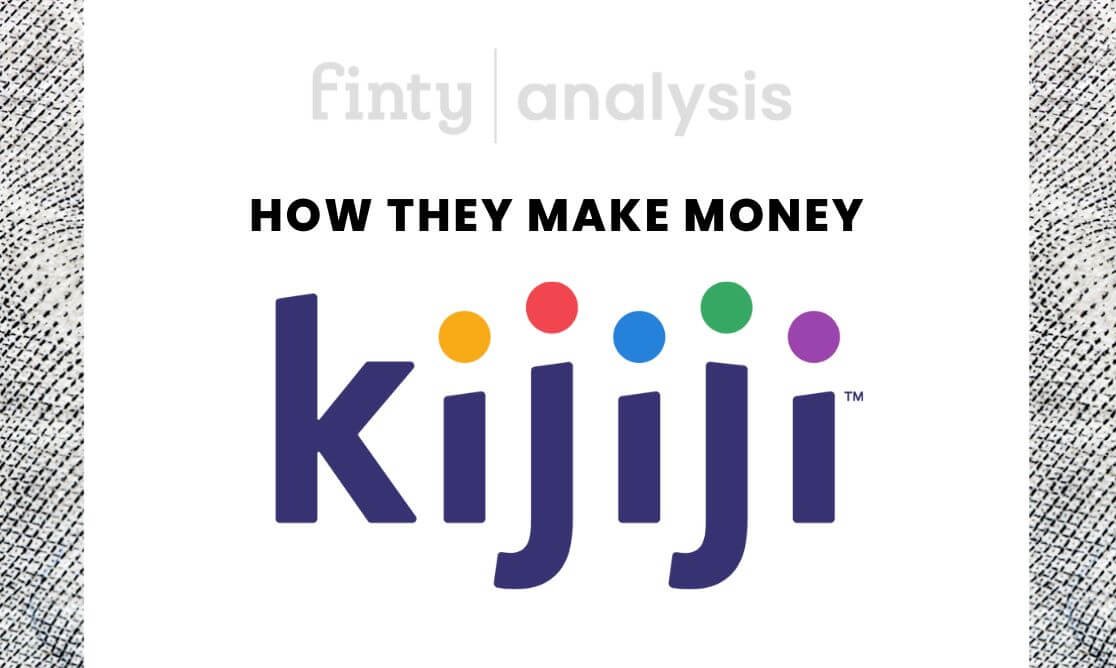Kijiji is a Canada-based online classifieds website acquired by Adevinta, a global marketplace specialist operating in 16 countries. Kijiji was originally launched as an eBay subsidiary in 2005. With Kijiji, you can connect with others in the community to exchange goods and services.
Scroll down to find out more about Kijiji’s business model and how they generate revenue.

Coming up next
What does Kijiji do?
Kijiji is Canada's largest classifieds site, facilitating connections between Canadians through millions of live ads spanning various categories such as cars, housing, jobs, and more.
Since its launch in 2005, Kijiji has offered a user-friendly platform for people within local communities to buy, sell, trade, and exchange goods, services, housing, and job opportunities.
With a commitment to sustainability and fostering a Second-Hand Economy, Kijiji enables users to find value in their community, reduce waste, and engage in environmentally-friendly local recycling.
How does Kijiji work?
Kijiji functions as an online marketplace where users can post and explore classified ads.
Users can click the "Post Ad" button, select a relevant category, and access the "Promote My Ad" table to view pricing for different features. Ads typically remain active for 60 days, with variations for certain categories like vacation rentals.
Users also have the option to enhance their ad's visibility with features like Top Ads, Bump Up, Highlight Ads, and more.
Reposting expired ads, which can be done up to 60 days after expiry, extends their visibility and can be boosted with features like Bump Up.
With this, Kijiji serves as a platform for users to connect with potential buyers or sellers within their local communities.
How does Kijiji make money?
Kijiji makes money by charging users for access to premium listing features and listing fees.
Premium features
Kijiji charges users for leveraging premium features like Top Ads, Bump Up, Highlight Ads, and more. These features enhance ad visibility, offering advertisers a strategic advantage. The pricing for these features is meticulously designed to strike a balance between attractiveness and maintaining their premium status. This approach ensures that the marketplace remains effective and clutter-free for users.
Listing fees
In addition to premium features, Kijiji applies listing fees to certain categories once users have exceeded their allocation of free ads. This approach encourages users to opt for paid advertising when they require more visibility for their listings. These fees vary based on categories and contribute to Kijiji's revenue while catering to advertisers' diverse needs.
Kijiji's revenue model is built on providing value-added features that enhance ad visibility, thus attracting users who are seeking effective and results-driven online advertising solutions. By facilitating successful transactions and fostering a robust trading environment, Kijiji ensures a steady stream of revenue while delivering tangible benefits to both buyers and advertisers.
Future growth engine
To further expand, Kijiji can explore strategies like tapping into social media networks like Facebook, Instagram, Twitter, TikTok, etc. These social networks represent an opportunity for Kijiji to significantly grow their business in the Canada market.
It can also start improving its mobile app features for seamless transactions, and using integrations with ecommerce platforms such as Shopify and buy now pay later services like Afterpay and Affirm could help engage younger demographics in Canada.
Furthermore, Kijiji could establish partnerships with sustainability initiatives, reinforcing its commitment to the Second-Hand Economy while promoting eco-conscious practices.
Risks
Kijiji operates within a dynamic online marketplace, subject to various potential risks that can impact its performance and growth prospects. These risks encompass challenges arising from the regulatory landscape, economic conditions, and evolving user preferences.
- Regulatory challenges. The regulatory landscape surrounding user privacy and data security poses a significant risk for Kijiji. Evolving data protection laws and increasing concerns about online privacy could lead to stricter regulations that impact how Kijiji collects, stores, and utilizes user data. Adapting to these regulatory changes while maintaining user trust and providing a seamless experience is a challenge the platform must navigate.
- Economic downturns. Kijiji's business model is closely tied to consumer spending. Economic downturns or uncertainties can impact user purchasing power, leading to decreased spending on both goods and services. Such shifts in consumer behavior could result in reduced demand for advertising services on Kijiji, affecting its revenue generation.
- Evolving user preferences. The evolving preferences of online users also pose a risk to Kijiji. As user behavior changes and preferences shift toward different online platforms or methods of engaging with classified ads, Kijiji must remain attuned to these trends. Failure to adapt to evolving preferences could result in a decline in user engagement and participation.
Balancing revenue generation with maintaining a positive user experience and ensuring a safe trading environment remains a challenge for Kijiji's business model.
Competitors
Kijiji operates within a competitive landscape of online classifieds platforms, where it contends with a variety of alternatives. Noteworthy contenders, such as Facebook Marketplace, Craigslist, VarageSale, and Letgo, offer users diverse options for their buying and selling needs.
- eBay. The listings giant is still a force to be reckoned with and is practically a verb for selling things online.
- Facebook Marketplace. A prominent competitor, Facebook Marketplace leverages its vast user network to provide a seamless buying and selling experience directly within the social media platform. This integrated approach attracts users seeking convenience and familiarity in their transactions.
- Craigslist. Known for its simplicity and broad reach, Craigslist offers a wide array of listings across categories. Its longstanding presence in the online classifieds realm gives it a substantial user base and challenges Kijiji to differentiate itself.
- VarageSale. VarageSale focuses on creating hyper-local communities for buying and selling. It emphasizes safety and trust through its closed-group model, allowing users to engage within their communities, which can be an appealing alternative for those seeking a more controlled environment.

